Plan checklist
The Walewski Property
56 Harris Street, Mirror Lake
Planting plan created by The District Municipality of Muskoka
Funded by •


Schedule A:
Plants & Property
Land Characteristics
This planting plan is designed based on the land characteristics identified during the day of the site visit. Plants are chosen according to the soil and light conditions on your property. The number of plants chosen for each planting compartment takes into account the square metre area of the space, as well as the amount of current vegetation cover. Your property is part of ecoZone: 5a
Land Characteristics by Compartment
| Length | Width | Area | pH | Soil | Moisture | Light | Height | |
|---|---|---|---|---|---|---|---|---|
| A | 4.4m | 18m | 79.2m2 | acidic | sandy | normal | partial sun, shade | any |
| B | 3m | 8m | 24m2 | acidic | sandy, loamy | normal | shade | any |
| C | 9m | 12.7m | 57.1m2 | acidic | sandy, loamy | normal | shade | any |
| 16.4m | 12.9m | 160.3m2 |
Plant Selection Summary
The following shrubs and trees are chosen for their suitability and survivability given the current soil and light conditions in each compartment on your property, as well as preferable features.
| Plant Species | A | B | C | Potted | Bareroot | Wildflower |
|---|---|---|---|---|---|---|
| Narrow Leaved Meadowsweet | 6 | 4 | 10 | |||
| White Spruce | 3 | 1 | 4 | |||
| White Pine | 1 | 2 | 3 | |||
| Witch Hazel | 1 | 1 | 2 | |||
| Sweet Gale | 1 | 1 | ||||
| Ninebark | 1 | 1 | 2 | |||
| Red Osier Dogwood | 2 | 3 | 3 | 8 | ||
| Black Spruce | 3 | 6 | 9 | |||
| Ostrich Fern | 6 | 6 | ||||
| Eastern White Cedar | 1 | 2 | 3 | |||
| Bush Honeysuckle | 3 | 3 | ||||
| Swamp Milkweed | 2 | 2 | ||||
| Blue Vervain | 1 | 1 | ||||
| Subtotal | 24 | 11 | 19 | 45 | 0 | 9 |
| Totals | 54 | |||||
Plant Information
The following table summarizes key information about each plant selected for your property.
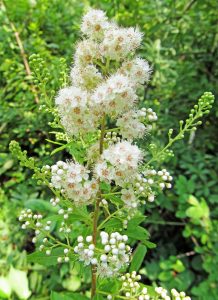
|
Narrow Leaved MeadowsweetHeight: 1-2m
The Narrow Leaved Meadowsweet is an erect, deciduous shrub, which grows in the shape of a mound to a height of 1-2m. This species develops numerous branches and branchlets, giving it a sparse appearance. Leaves produced are simple and narrow with sharply toothed borders growing alternately along the branches. These bright, light green leaves appear crowded, as they grow close together on the stocks and branches. During the fall, leaves turn a yellow-red or yellow-orange colour. Small white to light pink flower clusters appear in the spring growing in a dense, narrow pyramid at the terminal ends of the branches. During late summer to early fall, these flowers produce smooth, papery seed pods.
|
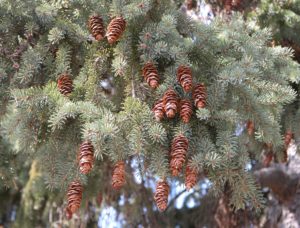
|
White SpruceHeight: 20m
The White Spruce is a hardy, coniferous tree species that grows up to 20 m in height. This species has a relatively uniform form with bark that is loose, scaly, and grayish brown. The needles are about 2 cm long and blueish green in color. The cones are 5-7 cm long, cigar-shaped, and have smooth margin scales. The bark of White Spruce is smooth and light grey when young, turning dark grey and scaly upon maturation. This tree is important for providing food and shelter to wildlife species including deer, porcupines, birds, and small rodents. White spruce is a long lived tree species, and usually lives 250-350 years old. However, individuals have been seen that have lived up to 1000 years old.
|
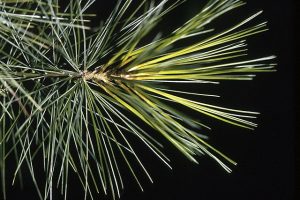
|
White PineHeight: 30m
The White Pine is Ontario's provincial tree. This species is the largest northeastern conifer with soft and light needles, which typically grows 30m in height. The needles are bundled into groups of 5 and are spirally spread around the twigs. White Pine bark is smooth and grey-green when young, becoming dark grey and deeply furrowed upon maturation. This tree produces yellow-green seed cones which are long, cylindrical, and covered in 50-80 scales. Unfortunately, this species is susceptible to White Pine Blister Rust and attacks by the White Pine Weevil. White Pine is a hardy tree which can tolerate a wide range of soil conditions, from sphagnum bogs to dry sandy and rocky ridges.
|
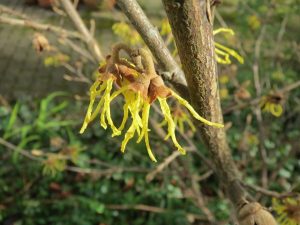
|
Witch HazelHeight: 4-9m
The Witch Hazel is a deciduous understory shrub, with a broad and rounded crown which typically grows 5-9m. This species can sometimes take on the form of a tree. Witch Hazel is most recognizable for its 2 cm long, spidery, bright yellow flowers, which bloom during late fall. Leaves produced are alternate, simple, 6-15 cm in length, and obovately shaped. These leaves are dark green on top with paler undersides and turn yellow during the autumn. Witch Hazel leaves produce hairs on their principal veins, are asymmetrical at their base, scalloped, and sometimes coarsely toothed. In addition, the leaves contain 5-7 straight, parallel, ascending veins per side. The twigs are slender, zigzagged, tawny, and smooth when mature. Witch Hazel fruiting bodies are short, thick, light brown capsules that become woody upon maturation. This species is typically multi-stemmed with two or more trunks, which are crooked and 10-15 cm in diameter.
|
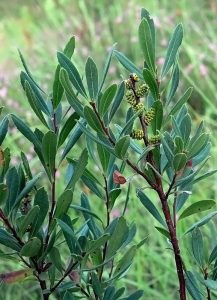
|
Sweet GaleHeight: 1-2m
Sweet Gale is a medium-sized shrub which grows into a thick bush about 1-2 m tall. This species produces 1-8 cm long, oblong-lanceolate leaves which are finely toothed at the tip and are spirally arranged. When bruised, these leaves give off a pleasant aroma. Male and female catkins are produced on separate plants. The seeds are dispersed from the female plants via water, as they float on two corky bracts. This shrub also provides a good food source for bird species that eat the seeds including Grouse, Chickadees, and Bluebirds. Mammal species like Beavers and White-Tailed Deer also browse on the twigs and leaves of this plant.
|
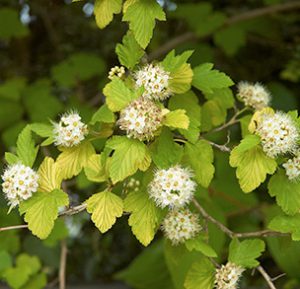
|
NinebarkHeight: 2-3m
The Common Ninebark is a very hardy, large (2-3m in height), deciduous shrub naturally occurring within riparian zones. This species is often planted as an ornamental shrub for its exfoliating bark which reveals reddish-light brown inner bark. This shrub is multi-stemmed with numerous horizontal and ascending branches creating a full, round shape. The Common Ninebark produces dull green, ovate to round shaped leaves with three to five lobes per leaf. During the fall the leaves turn brilliant yellow or dark purple. Between May and June, showy, bell-shaped flowers bloom in clusters on the terminal ends of the branches. During the summer, these flowers give way to small green or green-yellow berries which turn a bright red upon ripening.
|
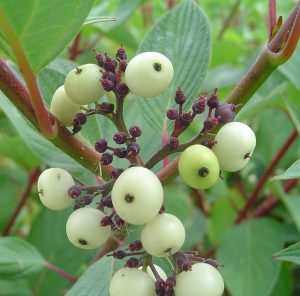
|
Red Osier DogwoodHeight: 1.5-4m
The Red Osier Dogwood is a medium-sized, deciduous shrub native throughout Northern and Western North America which typically grows to 1.5-4m. This species is multi-stemmed with numerous erect and ascending bright red branches that create a loose and spreading form. Leaves produced are simple, two-toned with a dark green upper side and light green underside. They are arranged opposite each other along the branches. During the fall, the foliage turns a brilliant red to dark purple. Clusters of small, creamy white flowers form on the terminal ends of the branches between June and July. The Red Osier Dogwood produces blueish-white fruiting bodies during late summer, which may persist throughout the winter. This shrub's berries provide an important winter food source for numerous species, from large deer to small wintering birds.
|
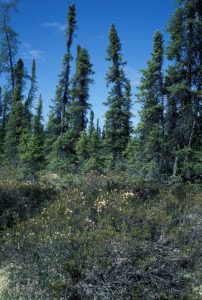
|
Black SpruceHeight: 20-30 m
The Black Spruce varies in size depending on soil conditions. On poorly drained sites, the trees are typically grow smaller and slower, up to 20m high and 30cm in trunk diameter. However, on well-drained upland sites, these trees can grow up to 30 m high and 60 cm in trunk diameter. The branches of the Black Spruce are comparatively shorter than other spruce species, and lower branches can appear extremely weighted and droopy. The crown of the tree is often very dense, and oddly shaped with many cones. The needles are short, single, and straight with blunt points, ranging from 8-15 mm in length. They are a dull grayish-green colour with lines of white spots on the under surface of the needle. Seed cones are broadly ovoid and egg shaped, 2-3 cm in length, and have a dark purplish-brown colour. The scales are brittle and tight fitting with an irregularly toothed margin. The cones mature around September and can remain on the tree for up to 30 years, gradually releasing seeds in normal conditions, while quickly releasing seeds following traumatic events, like forest fires. Open cones are almost spherical, brittle and toothed. The bark is reddish or grayish brown in colour when young, becoming darker, and boasting more prominent scales with age.
|
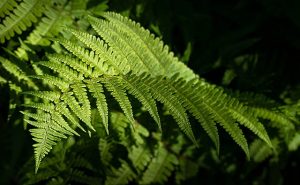
|
Ostrich FernHeight: 1.5 m
The Ostrich Fern is a coarse, erect to arching perennial fern, that can grow up to 1.5 m in height. The stems are clustered and arching while the leaves are ostrich-plume shaped, widest near top, and very gradually narrowed to the base. The size of the leaves grow up to 1.5 m long and 12-40 cm wide, with around 40 pairs of leaflets or pinnae. The leaflets are long, narrow-pointed, and ascending. The leaves are fertile, with spore clusters on the undersides of sub-leaflets.
|

|
Eastern White CedarHeight: 15m
Eastern White Cedar is a small evergreen tree which can usually live up to 300 years, although some individuals reaching 700 years old have been found. White Cedar produces unique green, opposite, scale-like leaves, which can take a fan-shaped form. They typically grow 15m in height. The bark is also distinguishable as it is reddish-brown, stringy and flaky, making it easy to peel off into long strips. White Cedars are also prone to heart-rot, leaving many trees with hollow centres. However, dried cedar bark is decay resistant making it a great option for use as fence posts or cedar-strip canoes. In addition, this species was historically used by indigenous people to prevent scurvy, earning the name 'tree of life'.
|
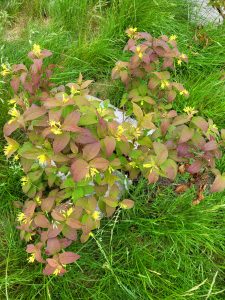
|
Bush HoneysuckleHeight: 1m
The Bush Honeysuckle is a small, hardy, deciduous shrub that rarely grows taller than 1 m in height. The leaves are simple, oppositely arranged, ovate shaped, and have finely toothed margins. During the spring and summer, the leaves are dark green in colour, then in the fall they take on a variety of colours ranging from a deep purple to light yellow. The flowers are small, showy, yellow to orange colored, trumpet shaped, appear in clusters on the tips of branches, and bloom between June and July. The flowers are beneficial to pollinator species, including hummingbirds and butterflies. The roots of the Bush Honeysuckle are fibrous, giving it the ability to form thickets and making it an ideal shrub to plant for erosion control.
|
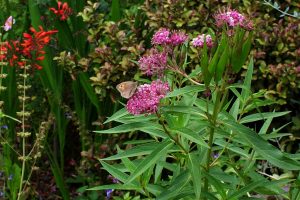
|
Swamp MilkweedHeight: 1 m
Swamp Milkweed is a beautiful wildflower species that typically grows about 1 m tall. The leaves are light green coloured, narrow, lance shaped, and oppositely arranged. The flowers are showy, fragrant, bright pink, appear in clusters on flowering stems, and bloom between July and August. The flowers give way to large, long and narrow, brown seed pods, which produce an abundance of seeds with tufts of long, white hairs. The flowers are beneficial to pollinator species, like bees and butterflies. As with all Milkweeds, the stem exudes a milky sap when broken, however the sap of the Swamp Milkweed is less milky than other species. This sap is critical for caterpillars of the endangered Monarch Butterfly to deter predators.
|
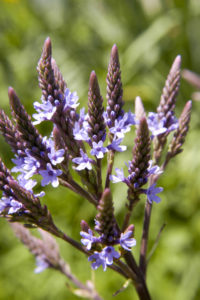
|
Blue VervainHeight: 1.5 m
Blue Vervain is a perennial wildflower species that grows about 1.5 m in height. It has a slender, upright form with reddish-green coloured, rough-haired stems. Its leaves are oppositely arranged, lance-shaped, and on short petioles with large serrations along the edge. Occasionally, there are two lobes present at the base of the leaves. The flowers are showy, blueish purple coloured, have five petals, appear on dense spikes at the top of flowering stems, and bloom between July and September. The flowers bloom first at the bottom of the spike, travelling upwards and blooming in bands. This plant spreads well and can form small colonies. The flowers are beneficial to pollinator species, like bees and butterflies. The seeds are also beneficial to wildlife species, like birds and small mammals.
|
Compartment A
Naturalization Area
Deer issues pH: acidic
pH: acidic Depth: potted
Depth: potted-
 Moisture: normal
Moisture: normal -
 Soil Type: sandy
Soil Type: sandy  Plant Height: any
Plant Height: any-
 Light conditions: partial sun, shade
Light conditions: partial sun, shade
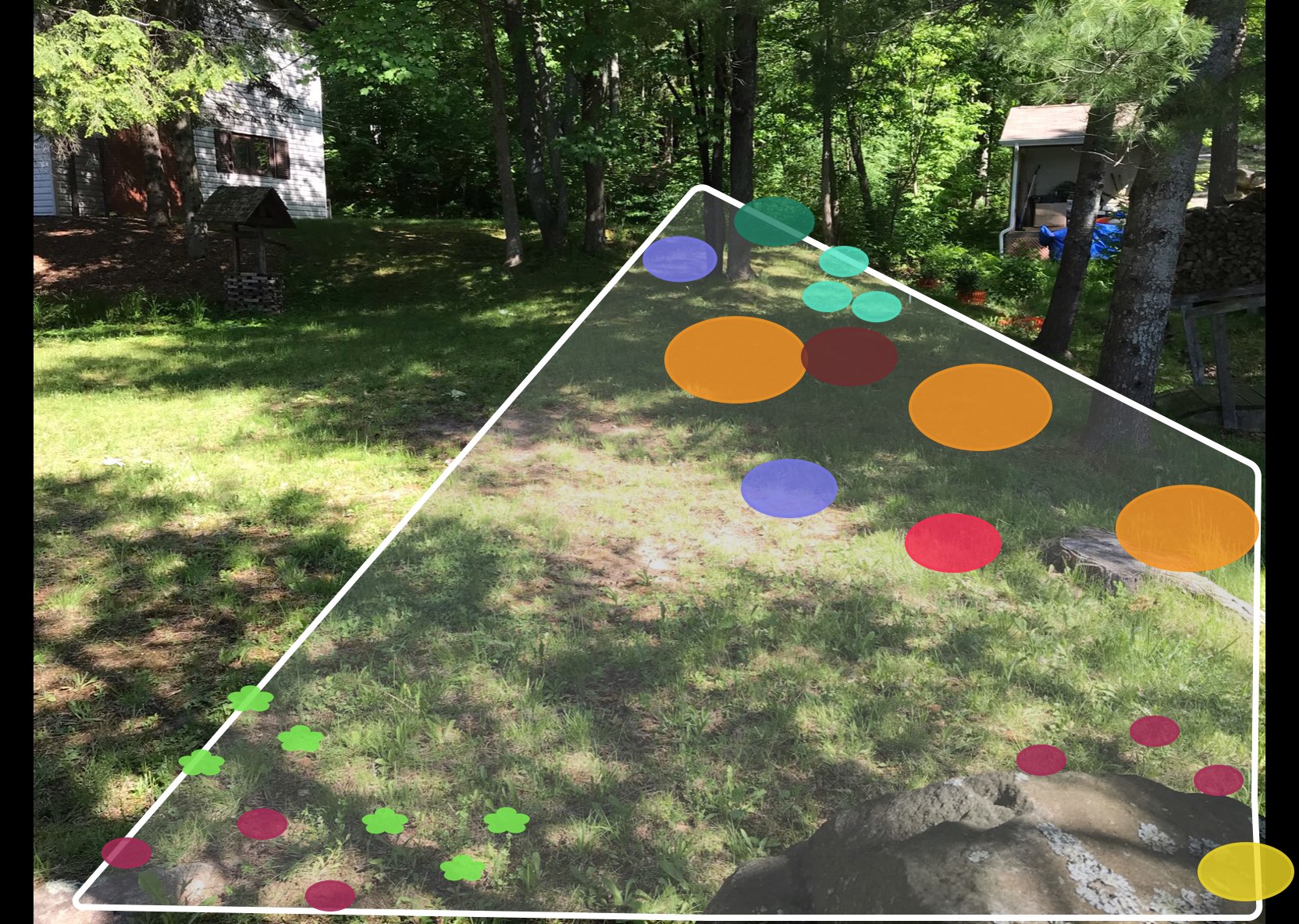
Compartment B
Naturalization Area
Deer issues pH: acidic
pH: acidic Depth: potted
Depth: potted-
 Moisture: normal
Moisture: normal -
 Soil Type: sandy, loamy
Soil Type: sandy, loamy  Plant Height: any
Plant Height: any-
 Light conditions: shade
Light conditions: shade
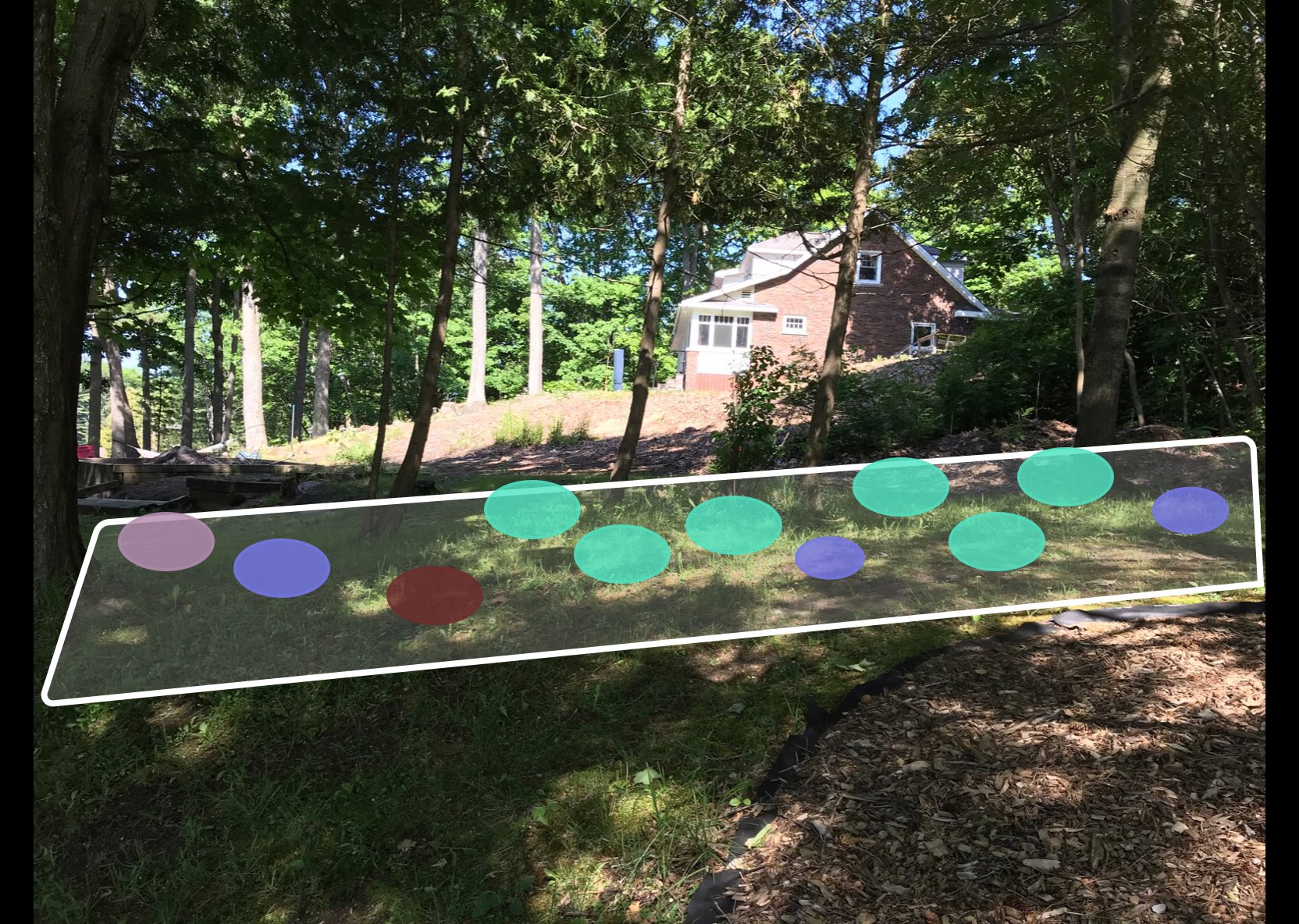
Compartment C
Naturalization Area
Deer issues pH: acidic
pH: acidic Depth: potted
Depth: potted-
 Moisture: normal
Moisture: normal -
 Soil Type: sandy, loamy
Soil Type: sandy, loamy  Plant Height: any
Plant Height: any-
 Light conditions: shade
Light conditions: shade
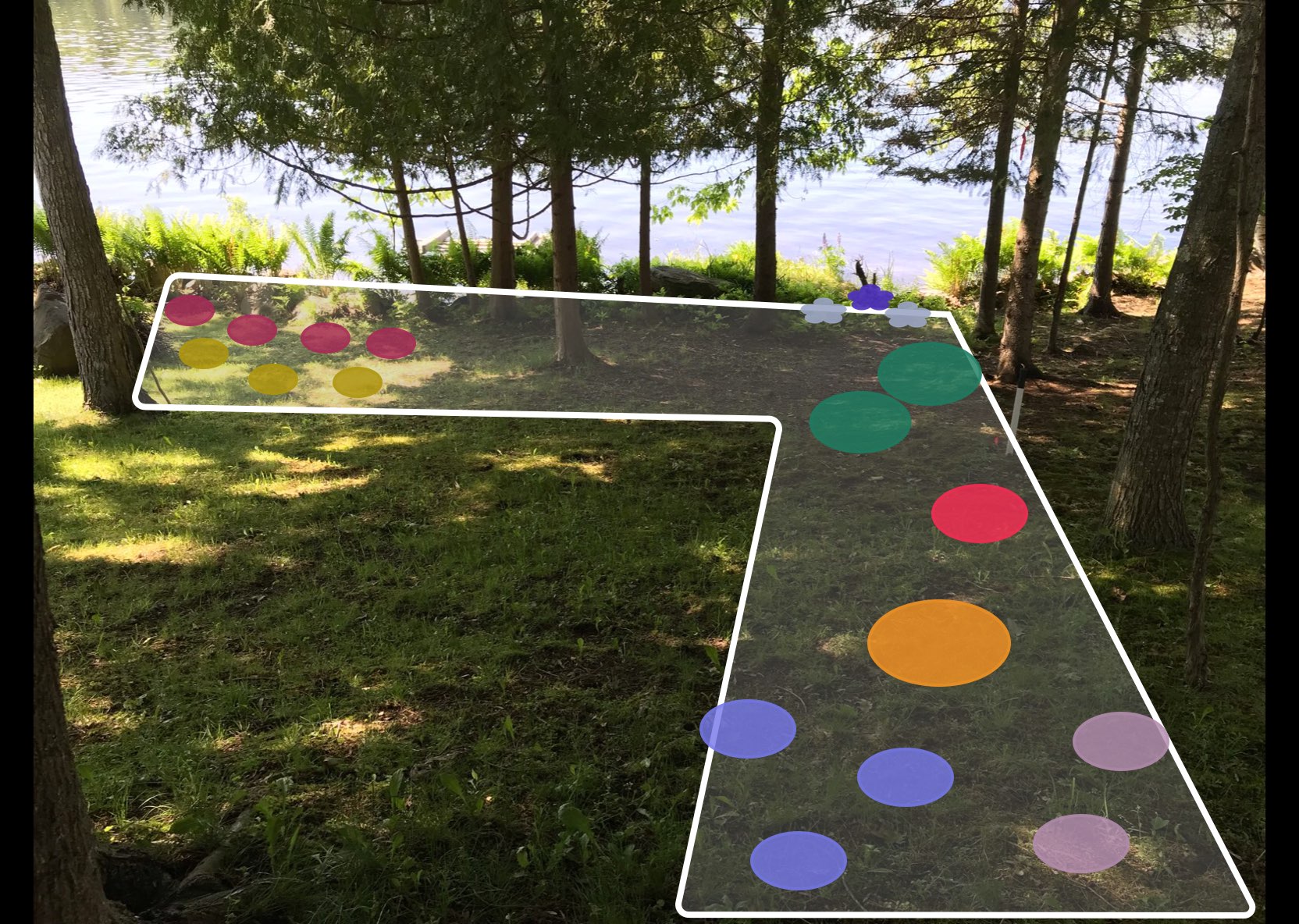
Schedule B
Financial Summary
Project by: The District Municipality of Muskoka
Shoreline Re-Naturalization Starter Kit includes: free site visit, customized re-naturalization planting plan for your shoreline property, native plants including free bare root (small) and potted (large) plants and wildflowers, coconut fibre pads to deter grass from growing around new plantings, tree guards for all deciduous trees, mulch for your wildflowers, Plant Care Guide with instructions on how to take care of your new plants, Habitat Creation Guide and a Wildflower Garden Guide.
Our planting plans are created onsite with you and provide detailed information and plans to re-naturalize your shoreline property. We take photos of areas for planting and overlay native plants that are well suited to your property based on site conditions such as soil type and sunlight availability.
We will work with you to create a plan that works for you including options for low growing plants in areas where views are important.
| Item | Quantity | Cost/Item | Subtotal |
|---|---|---|---|
| Starter Kit fee | $300 | ||
| Free potted plants | 20 | $0 | $0 |
| Paid potted plants | 25 | 12.00 | 300.00 |
| Free bareroot plants | 0 | $0 | $0 |
| Free wildflowers | 9 | $0 | $0 |
| Total costs | 600.00 |
Schedule C
Project Agreement
Stewardship Agreement
Please indicate your agreement to this proposed plan by signing the following Stewardship Agreement and submitting it, along with your financial contribution, to:
The District Municipality of Muskoka
70 Pine Street
Bracebridge, Ontario
P1L 1N3
Plant Availability
Please note that plant species may need to be changed based on plant stock availability at the time of ordering.
Project Completion
Upon receiving your signed stewardship agreement and financial contribution, a date will be booked for you to pick up your Natural Edge Kit. The District Municipality of Muskoka will supply all plants and materials. If you are paying for the planting to be completed for you, a date will be arranged for The District Municipality of Muskoka to plant your shoreline, bringing the plants and materials with them. If there are particular dates that you would prefer, we will do our best to accommodate your requests.
The Natural Edge Stewardship Agreement with The District Municipality of Muskoka
Agreement made this 15th Day of the Month of June in the Year 2020.
BETWEEN Barb Walewski 56 Harris Street Port Carling Ontario (Hereinafter called the OWNERS)
AND The District Municipality of Muskoka 70 Pine Street Bracebridge, Ontario P1L 1N3 (Hereinafter called DMM)
WHEREAS the Owners and DMM have met and discussed plans for shoreline naturalization on the specified area(s) in Schedule A existing on the Owners’ land;
WHEREAS the Owners indicate approval of the project as proposed; and
WHEREAS the project is, or will be for the benefit of the Owners and others;
NOW THEREFORE THE PARTIES AGREE AS FOLLOWS:
1. This Agreement shall be in effect for a period of 5 years, commencing with the date of this Agreement.
2. The Owners and DMM agree that the areas where the work is to be performed is as described in Schedule A.
3. The Owners agree to pick up their Natural Edge Starter Kit from DMM’s office and plant their shoreline within two days of receipt. The Owners will provide “after” photos of the work completed to be used for reporting purposes. If the Owners wish to have the planting completed for them, then DMM or it’s contractors, employees and agents will complete the planting at cost, as indicated in Schedule B.
4. If the planting is to be completed by DMM, then the Owners grant DMM, its contractors, employees and agents, the right to enter the property to perform the work agreed upon as outlined in Schedule A. In addition, DMM, its contractors, employees and agents may inspect the work performed for the purposes of monitoring the project and survival assessment, with prior agreement with Owners for date and time of inspection.
5. The Owners agree to contribute the “Landowner contribution” and pay the costs indicated in Schedule B.
6. In instances where the Owners are to pay DMM for work to be performed (outlined in Schedule A), the Owners agree to provide payments to DMM prior to the commencement of that operation. Failure of payment shall constitute a breach of this Agreement and the Owners agree that this Agreement will be terminated and thereupon the Owners agree to pay DMM the estimated costs of the operations of the project completed to date, if any.
7. The Owners agree, if necessary, to perform a reasonable amount of maintenance, which is described in the Native Plant Care Guide, available at naturaledge.watersheds.ca.
8. If a contractor is required to perform the work outlined in Schedule A, then the contractor carrying out the work on the land described will be required to take out and furnish evidence of a comprehensive policy of public liability and property damage coverage. The contractor and their workers will be required to be in good standing with the Workplace Safety and Insurance Board (WSIB) prior to performing the work.
9. The Owners agree not to remove, destroy or alter the project without prior consultation and approval of DMM. Pruning and trimming planted nursery stock, or adding replacement native nursery stock is exempt.
10. The Owners agree not to mow the planted area.
11. The Owners do acknowledge that DMM, its contractors, employees and agents, having performed said works, are not under further obligation with respect to survival of nursery stock, inspection, or maintenance.
12. The Owners, in the absence of negligence, hereby remise, release and forever discharge DMM, its contractors, employees and agents from all claims and demands for injuries, including death, loss, damages and costs in any way related to or connected with installation and maintenance of the work described or resulting from any deleterious effects of the work to the land or to the lands and buildings thereon retained by the Owners.
IN WITNESS WHEREOF the parties have agreed to the contents of this plan; SIGNED:
About this program
About The District Municipality of Muskoka
The District of Muskoka is an upper-tier municipality that has monitored water quality in Muskoka area lakes since 1980. Since 2002, the Muskoka Water Strategy has provided integrated and strategic initiatives for the protection of Muskoka's water resources. The purpose of the strategy is to guide and minimize the impact of human activities on water resources; ensure human and environmental health; and preserve the quality of life in Muskoka.
This program was created by Watersheds Canada
We believe that every person has the right to access clean and healthy lakes and rivers in Canada. At Watersheds Canada, we work to keep these precious places naturally clean and healthy for people and wildlife to continue using for years to come. We love working with others to meet the needs of local communities, whether you’re a concerned citizen, a landowner, a lake association looking for help, or a coalition of groups interested in activating your local community.

